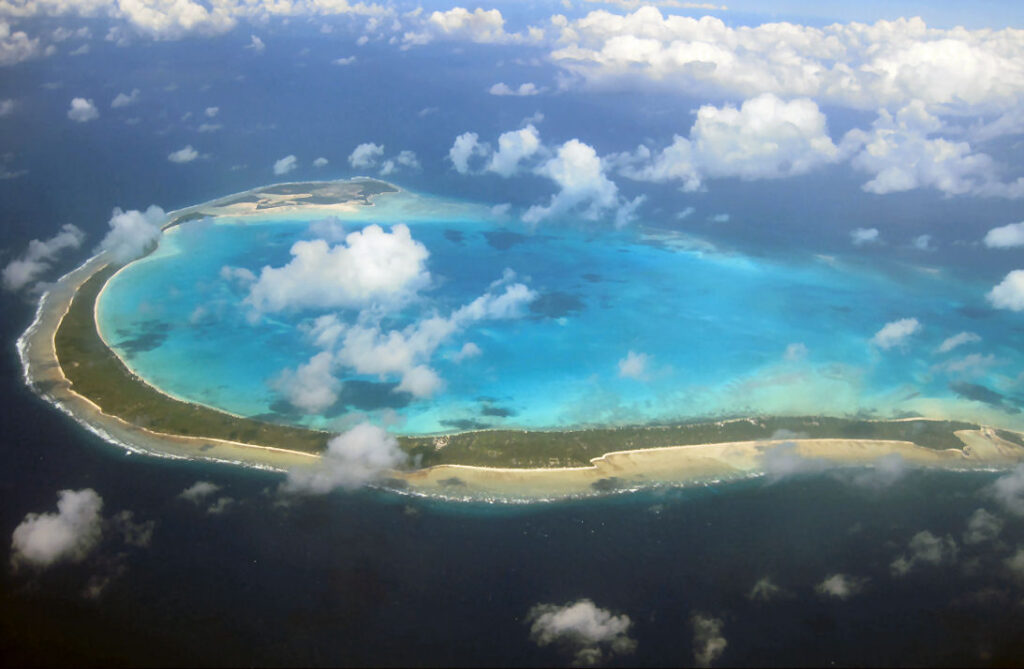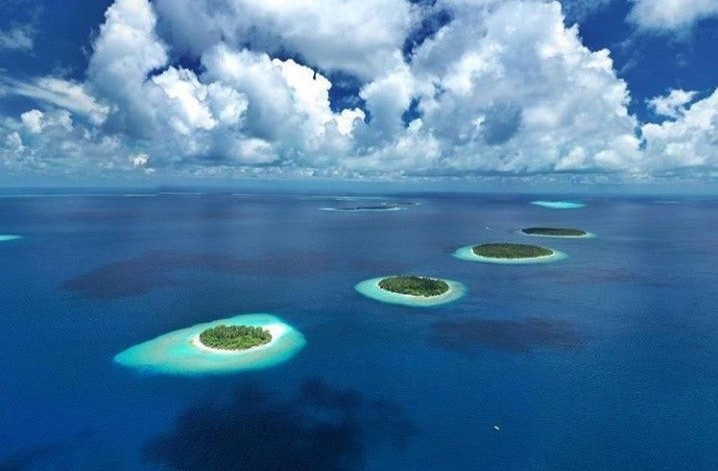Climate at a Glance: Islands and Sea Level Rise.
 Onotoa Atoll, Gilbert Islands, Republic of Kiribati, Central Pacific. CC-SA WikiPedia
Onotoa Atoll, Gilbert Islands, Republic of Kiribati, Central Pacific. CC-SA WikiPediaView this page in our printable booklet (PDF) here:
Key Takeaways:
- Most islands and atolls in the Pacific Ocean, including Tuvalu, are growing, not shrinking.
- As the sea gradually rises, the sea brings sand and sediment along with it, building up the height of islands along with it.
- Despite many predictions that island nations in the Pacific would spawn waves of climate refugees, the population of Tuvalu and other islands have steadily grown, not decreased.
Short Summary:
Objective scientific evidence refutes claims that climate change is causing small islands to disappear under rising seas. Rising seas bring sand and sediment, which build up coastal shorelines along with rising waters. Also, coral, as living organisms growing near sea level, build up their height along with the rising sea, as seen in Figure 1.
 Figure1. Coral atolls, Maldives. Note that the coral rings “float” with the sea level, and because they are living things, they rise with the sea level as new coral grows. Source: Pinterest
Figure1. Coral atolls, Maldives. Note that the coral rings “float” with the sea level, and because they are living things, they rise with the sea level as new coral grows. Source: PinterestClimate change activists routinely argue that numerous Pacific Islands will soon be under water due to rising sea levels caused by climate change. But recent population patterns suggest Pacific Islanders know they are not facing substantial threats from sea-level rise. Some allegedly “endangered” islands have even built or made plans to build new airports or resorts.1,2
Even more importantly, objective scientific evidence debunks claims that climate change is causing small islands to disappear. Rising seas bring sand and sediment, which build up coastal shorelines, often offsetting higher-than-usual sea levels.
An important example is the island of Tuvalu. Climate activists often claim the island nation of Tuvalu is sinking because of rising seas. However, a recent peer-reviewed study found eight of Tuvalu’s nine large coral atolls have grown in size during recent decades, and 75 percent of Tuvalu’s 101 smaller reef islands have
increased as well.3
An important example is the island of Tuvalu. Climate activists often claim the island nation of Tuvalu is sinking because of rising seas. However, a recent peer-reviewed study found eight of Tuvalu’s nine large coral atolls have grown in size during recent decades, and 75 percent of Tuvalu’s 101 smaller reef islands have
increased as well.3
Further evidence can be found in Tuvalu’s population records. Many climate activists have warned that rising seas have started to cause or will soon cause waves of climate refugees seeking to flee islands like Tuvalu. However, Tuvalu’s population, like the population of many other island nations, has consistently grown in recent years, not declined. At the time of this publication, the population of Tuvalu had increased by 20 percent over the previous 30 years, and it had doubled compared to its population recorded in 1970.4
Additional peer-reviewed studies have confirmed other islands in the Pacific Ocean are keeping up with rising sea levels.5,6 Their atolls have gained more than enough height and mass to offset modest sea-level rise.7
Climate activist groups and some scientists have been making false dire warnings about sea-level rise for many
decades. For instance, more than 30 years ago, the AFP international news agency reported all 1,196 islands that comprise the Maldives could be completely underwater over the next few decades.8 Not only are all 1,196 islands still above water, people from all over the world are flocking to the Maldives, not fleeing them. Like Tuvalu, the Maldives are benefiting from a lucrative tourist trade, not spawning climate refugees.
Additional peer-reviewed studies have confirmed other islands in the Pacific Ocean are keeping up with rising sea levels.5,6 Their atolls have gained more than enough height and mass to offset modest sea-level rise.7
Climate activist groups and some scientists have been making false dire warnings about sea-level rise for many
decades. For instance, more than 30 years ago, the AFP international news agency reported all 1,196 islands that comprise the Maldives could be completely underwater over the next few decades.8 Not only are all 1,196 islands still above water, people from all over the world are flocking to the Maldives, not fleeing them. Like Tuvalu, the Maldives are benefiting from a lucrative tourist trade, not spawning climate refugees.
References:
- Anthony Watts, “FAIL: 30 Year-Old Climate Prediction Proves to Be a Load of Bunkum,”
WattsUpWithThat, March 10, 2018, https://wattsupwiththat.com/2018/10/03/fail-30-
year-old-climate-prediction-proves-to-be-a-load-of-bunkum - Eric Worrall, “Kiribati Climate Plan: More Resorts, More Tourists,” WattsUpWithThat,
November 21, 2017, https://wattsupwiththat.com/2017/11/21/kirabati-climate-planmore-
resorts-more-tourists - “‘Sinking’ Pacific Nation Is Getting Bigger: Study,” Phys.org, February 9, 2018, https://
phys.org/news/2018-02-pacific-nation-bigger.html - “Tuvalu Population,” worldometer.info, https://www.worldometers.info/worldpopulation/
tuvalu-population - Megan Tuck et al., “Physical Modelling of the Response of Reef Islands to Sea-Level
Rise,” Geology, Volume 47, No. 9, September 1, 2019, https://pubs.geoscienceworld.
org/gsa/geology/article-abstract/47/9/803/572047/Physical-modelling-of-the-responseof-
reef-islands?redirectedFrom=fulltext - Paul S. Kench, Murray R. Ford and Susan D. Owen, “Patterns of Island Change
and Persistence Offer Alternate Adaptation Pathways for Atoll Nations,” Nature
Communications, February 9, 2018, https://www.nature.com/articles/s41467-018-
02954-1 - Willis Eschenbach, “Floating Islands,” WattsUpWithThat, January 27, 2010, https://
wattsupwiththat.com/2010/01/27/floating-islands/ - “Threat to Islands,” AFP, republished by Canberra Times (Australia), September 26,
1988, https://trove.nla.gov.au/newspaper/article/102074798
.jpeg)